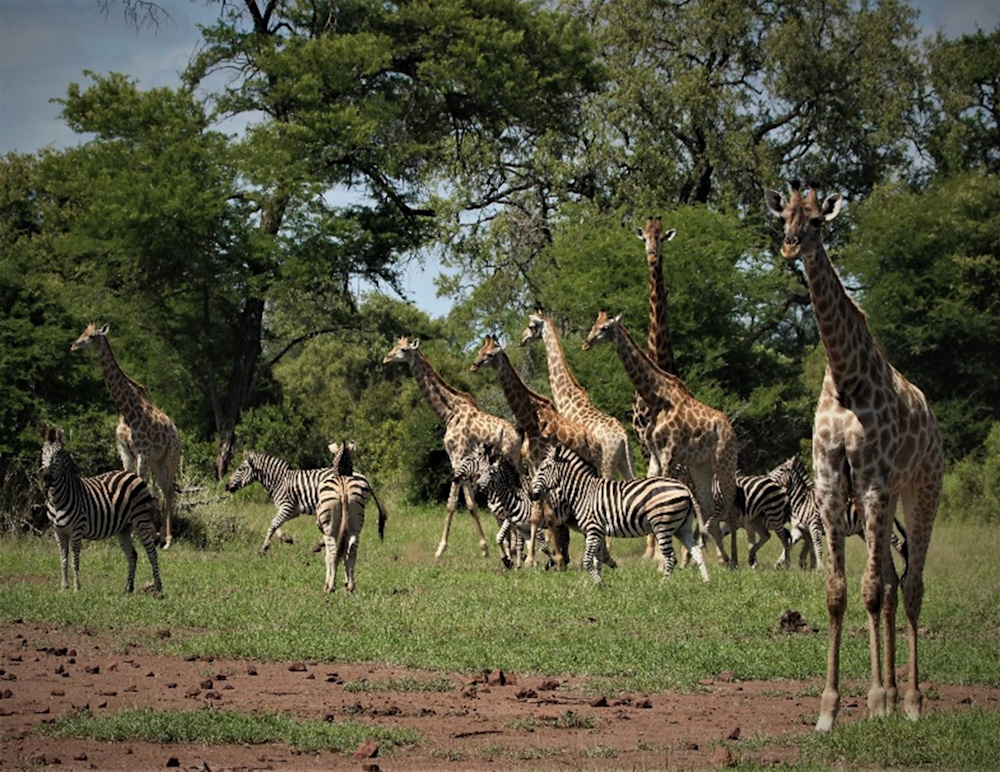December 2022
Singita Kruger National Park: December 2022
Share:
Singita Kruger National Park: December 2022
The month of December which is officially the first month of summer here has brought on more rains throughout the concession, making the pans across the concession overflow, and giving wallowing animals plenty of options for them to take their mud baths in the heat of the summer days. There are still new shoots of greenery sprouting out of the ground and bare branches, giving the herbivores an abundance of fresh food.
A Sightings Snapshot for December follows:
Lions
Lion sightings have been good in December with the Mananga Pride being one of our stable prides in the north. We have seen a slight shift in the pride dynamic as the pride was initially split into the smaller portion (two lionesses and six cubs) and the larger portion (fifteen pride members), but towards the end of the month we saw a further division between the larger portion into eleven and four.
The larger portion of the Mananga Pride has been seen all across their territory both eastern and western side of our western boundary, and on occasion they have been seen looking very hungry. We think the cubs are now starting to participate in hunting trying to assist the adults but they do not have experience and they mess up the hunting opportunities! They have also been seen with very full bellies on occasions, and they made a double wildebeest kill at Golf Course Clearing which provided enough food for the whole pride for two days.
The smaller portion of the Mananga Pride has been sighted on numerous occasions in and around the Gudzane Dam area.
The Shishangaan males have also been spotted in the concession, but not as frequently as previous months. We have seen them separated on a few occasions and spending time with the smaller portion of the Mananga Pride.
Shish Pride was seen around the southern parts of the concession. One lioness was missing, however, the next day she was seen mating with a Trichardt male near camp. The Shish lionesses do not have stable males that we can say are dominant at this moment, the kingship in the south is up in the air with many coalitions trying to take the throne.
The Trichardt males are having a hard time protecting their new territory. We have had three relaxed nomadic males come in following the Shish lioness, that chased the Trichardt males away.
The Maputo male has also been seen on a few occasions in the central parts of the property vocalizing and marking his former territory.
Leopards
We spotted a big male leopard around Xigamba Pan feeding on an impala lamb, and were not able to identify him, as one of the regular leopards we see in the area.
Another unknown male was spotted around golden oriole, and was a little more cautious about the vehicle presence than the male we saw around Xigamba Pan.
Nhlanguleni female and the cubs have been spotted around the central area, and we viewed them feeding on a fully grown impala female west of the central depression. After they had fed for three days, a mating pairs of leopards arrived and the male took over the carcass and finished it off.
The Dumbana young males were spotted in Ntsimbitsane, Ostrich-link, and Dave’s Crossing areas, and they have been moving north up to Name-badge Hill, providing us with remarkable viewing opportunities. Their mother has been away for most of the month but she was seen on a number of occasions and is believed to be pregnant, after viewing her mate with two different male leopards a few months ago. We tracked her all the way to Sisal/Nyokeni, suspecting that she might be looking for a place to give birth.
A relaxed adult female was also seen around Gudzane Dam on a few occasions, stalking impala.
Wild dogs
We had great sightings of wild dogs this month, there are three different packs that we have been seeing, a pack of five, a pack of nine, and eleven. The pack of five was first seen around Maputo/Sisal, and they seem to be hanging more around the eastern part of the concession.
The pack of nine was seen coming from H6 public road in the Kruger and they have been in the concession for about two days moving north towards the Warthog Pan area.
A pack of eleven wild dogs was located on Milk-berry and they were followed until they settled down at Ostrich Link open areas. Two days later they were spotted again at Mondzo Pan and they had blood on their faces, there was also a lot of vultures around in the distance. The same pack was seen again on Ntsimbitsane feeding on an impala lamb.
Spotted hyenas
We still don’t have a confirmed den-site on the concession, but we have been very lucky with hyena sightings. We had a couple of single hyena sightings around the Ostrich Link and Ma-4-pounds area.
A single adult and two sub-adults were recorded being seen at Mbeki's Crossing coming from the west in Kruger, they might have a den-site along the drainage west of Mbeki drainage outside of the concession.
A clan of twelve was seen at a golf course clearing trying to scavenge from the lions that killed two wildebeest.
A number more clans were seen on several occasions across the concession, mostly in the general vicinity of the wild dogs, but not restricted to that area.
Elephants
We are blessed with elephant sightings! The basalt grassland has been feeding a lot of different animals with good palatable grass this summer. We have recorded a couple of large herds around the basalt grasslands moving east below the mountains. Elephant bulls in musth were seen following the herd.
A lot of different herds were also seen in the southern section of the concession, especially in and around the Sticky Thorn area. We had a lot of rain in the eastern part of the concession and this is attracting the elephants to come for good grazing.
We have also seen a number of lone elephant bulls in immaculate condition with impressive tusks and overall size.
Buffalos
On occasion we have a large herd that comes from the northern boundary around Mbatsane Firebreak and splits into two groups, some heading towards Nhongo and the other group heading south to Mangwa Road. Both herds stay for a few days in the concession, then slowly move back north or west.
A few buffalo bulls were sighted on our concession, around Sisal region.
Plains game
The general game has been extremely good almost everywhere in the concession - we have had remarkable sightings of towers of giraffes, wildebeest with brown calves, dazzles of zebras, and quite a lot of impalas. We are very privileged because most of our open grasslands have natural pans around them and that creates a favourite place for most of the general game, with food nearby and water. They also feel safe because it is open enough for them to be able to see predators approaching them.
Kudu and the waterbuck population seem to be on a steady increase. We had good sightings of them all along the N’wanetsi River, including the central depression area. Even when we drive to the east towards the mountains, they never disappoint us, and they are always there.
Rare animals and other sightings
A mother cheetah and two sub-adults were spotted a few times around the central depression area, and they have been seen hunting and killing two impala lambs. The sub-adults can hunt and the other impala lamb was killed by one of them.
A single female cheetah was seen around Basalt/ Gudzani-east hunting and ended up going back into Kruger. The next day she was also found north of Xingwenyana Crossing feeding on an impala lamb.
A number of klipspringer pairs were seen all over the concession
Birds
A thick-billed cuckoo was spotted around the central area near Cub’s Crossing for the first time in the concession.
Crested guinea fowl were also spotted on the eastern boundary around Maputo/fence-line.
We had quite a few sightings of eastern nicators around the lodge and they have been very vocal, contacting each other.
A couple of greater painted snipes have been recorded around the N’wanetsi Crossing/Sisal-line, and Euphorbia Crossing.
A male shaft-tail whydah was spotted around the Cassia open area.
We have had a large number of waterbirds wading in the N’wanetsi River, congregating around small pans of water that have created fish-traps.


By Jenny Hishin
Author / Field Guide